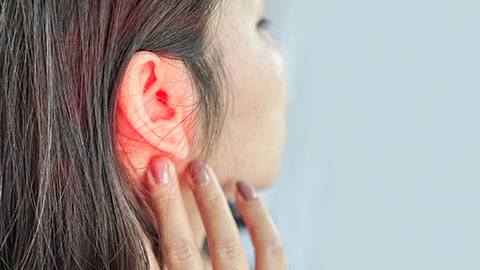01/08/2021

Today we take a deep dive . . . into the ear. We look at a client who had a sinus infection with lingering ear stuffiness. Magically, it resolved with massage! The MT naturally wants to know, “What happened? And can I make it happen again?”
.png)
Resources
Hayes, Kristin. “What Causes the Accumulation of Fluid in the Ear?” Verywell Health. Last modified November 2019. Accessed January 2021. www.verywellhealth.com/diagnosis-and-treatment-for-fluid-in-the-ear-1192211.
Hoffman, Matthew. “Picture of the Ear.” WebMD. Accessed January 2021. www.webmd.com/cold-and-flu/ear-infection/picture-of-the-ear#1.
Llewellyn, A. et al. (2014). “Interventions for Adult Eustachian Tube Dysfunction: A Dystematic Review.” Health Technology Assessment 18, no. 46. Accessed January 2021. www.ncbi.nlm.nih.gov/books/NBK262265.


This episode sponsored by:
0:00:00.0 Speaker 1: Ruth Werner's best-selling book, A Massage Therapist's Guide to Pathology is a highly regarded comprehensive resource that sets the standard for pathology education. Written for massage therapy students and practitioners, this groundbreaking resource serves up a comprehensive review of the pathophysiology, signs, symptoms, and treatment of more than 500 diseases and disorders. Learn more at booksofdiscovery.com.
[music]
0:00:39.6 Ruth Werner: Hi, and welcome to I Have A Client Who, pathology conversations with Ruth Werner. The podcast where I will discuss your real life stories about clients with conditions that are perplexing or confusing. I am Ruth Werner, author of A Massage Therapist's Guide to Pathology, and I have spent decades studying, writing about and teaching about where massage therapy intersects with diseases and conditions that might limit our client's health. We almost always have something good to offer even with our most challenged clients, but we need to figure out a way to do that safely, effectively and within our scope of practice. And sometimes, as we have all learned, that is harder than it looks. This episode comes from a note from someone who sent their description to the special, I Have A Client Who email address, that's, ihaveaclientwho@abmp.com, all lowercase, all one word, and her note gave me the chance to revisit the anatomy of the ear. We don't teach a lot about it in massage school, but it is super cool. Today's story goes like this.
0:01:53.5 RW: "I have a client who just came in for her first appointment since February of last year. She told me she'd had a bad sinus infection in July that cleared with one round of antibiotics. She's in her early 40s and said this was the first sinus infection she has ever had. Everything has returned to normal except for her right ear, which still feels blocked. She doesn't notice hearing loss except for at night when her good ear is pressed against the pillow, then she notices she can't hear as much through that right ear. She noted that she went to Vermont a few weeks ago, and driving up and down the mountains caused her left ear to pop, but her right ear remained unchanged. So I did the massage and I did some extra work to her right neck, the under side of her jaw, the skull, all around her right ear, the occipital area, and also the forehead and temples. In non-pandemic times I would have worked with her cheeks and full jaw, but I didn't this time because she was masked. After the massage, she said she could feel movement in her right ear and also felt it pop. There was no pain or anything intense enough to cause pressure."
0:03:11.6 RW: "So my question is this, can massage really make fluid or anything move in the inner ear? My gut says yes, because she felt something change, but I truly have no idea what could be happening via massage or how, and I'd love to know more. So if she returns, I can take a more skilled approach if the issue is persistent." Oh, this is a terrific question. And to talk about it, we will have a brief visit with our wonderful ears. You may remember that our ears have essentially three different regions, the outer ear consists of the pinna, that's the part you can grab, and the canal that leads up to the tympanic membrane, which is also called your eardrum. The middle ear is a chamber that separates the outer ear from the inner ear. The middle ear also connects to the throat, it's lined with mucous membrane and it helps to stabilize the air pressure on either side of the eardrum, so that that tympanic membrane can vibrate and send accurate messages via those tiny ear bones into the part of the vestibulocochlear nerve that transmits messages about vibrations that we then interpret as sound.
0:04:28.3 RW: And then the inner ear includes that bizarre structure that looks like a seashell, it's called the cochlea, and it helps us to be oriented in space. The nerve endings inside the cochlea tell us where we are in relationship to the horizon. It has a section for horizontal orientation, for vertical orientation, and for diagonal orientation, and it is monster cool. I will find a great picture of the cochlea to include in today's show notes. When we get conflicting messages from our eyes and from our vestibular nerves in the cochlea, this leads to all kinds of problems, like dizziness and a sensation of spinning or vertigo. There's a lot more to say about this that I'd love to go into, but I will save that for when some day someone sends me an, I Have A Client Who story about someone who has benign positional, paroxysmal vertigo or some other vestibular balance problem.
0:05:25.5 RW: For our purposes today, we need to think about that middle ear chamber. It is connected by a duct into the nasopharynx, that's a fancy word for the back of the throat, and that duct is called the eustachian tube. The eustachian tube is meant to be closed most of the time, but under certain circumstances, like when we yawn or chew or swallow or do some other specialized activities, the eustachian tube can open, and this allows us to equalize the air pressure between the middle ear and the outside world, so that that tympanic membrane can work better and we hear more clearly. The eustachian tube can also help to drain excess fluid out of the middle ear, but only when it's unblocked and flowing freely. When a person has an upper respiratory tract infection, especially one that affects the sinuses, like the client in this story, the middle ear can fill up with gluey mucus, and this interferes with vibrations to the eardrum, so one of the symptoms is a sense of muffled sound along with that feeling like our ear is full.
0:06:35.6 RW: And if that mucus is thick and sticky and it doesn't move much, then that sense of fullness and impaired hearing, that can persist for quite a long time, especially if the eustachian tubes themselves are also inflamed and not draining well. So what seems clear to me happened in this case was that that gentle bit of facial and neck massage that this massage therapist did helped indirectly to stretch and open the eustachian tubes in such a way that the air pressure could equalize between the inside and the outside of the middle ear, and this gave the client some wonderful relief. So, let's look again at our contributor's question, she says, "My question is this, can massage really make fluid or anything move in the inner ear? My gut says yes, because she felt something change, but I truly have no idea what could be happening via massage or how. And I'd love to know more, so if she returns, I can take a more skilled approach if the issue is persisting."
0:07:41.4 RW: Well, now we can add a bit of clarification, massage probably didn't move anything in the inner ear, but it's very likely that her pressure on the facial tissues stretched the eustachian tubes in such a way that the middle ear could drain. And this therapist said she'd love to know more, so if the client returns she can take a more skilled approach. Well, I have some good news. If this is an area in which you would like to specialize, I recommend that you get some advanced education in manual lymphatic drainage or lymph drainage technique. I checked in with one of my go-to resources about lymphatic work, Lisa Santoro, who by the way, just graduated with a degree in psychology and a minor in nutrition, so congrats, Lisa. And I asked her, if there is a specific protocol for eustachian tube draining? And here's what she said, she said, "Absolutely. We start with the big four, open the channels, then up to the face and outside of the cone of the nose, then to the water wheel, which is a chicly term for an area in the parotids, think around the TMJ, then posterior to soft gloppy feeling in between."
0:08:52.2 RW: "It has a more circular flow versus inferior to the clavicle nodes, those are salivary glands, but their sisters in crime are posterior to the ear, the retro auriculars in the mastoid nodes. There's a sequence that goes up and out through the ear and then back down to clavicular draining the whole chain. It drains the whole sinus, the nose, ears, jaw, and the deep sinuses." Now, Lisa's description would make a lot more sense in the context of actually having had this education, but I think we can gather the gist. This sounds like a process that would be amazing for people with clogged sinuses, from allergies, and those who have congestion in their ears, and their nose, as long as any infection has cleared up and is gone. Our contributor today had success with her client's ears by accident, and that's awesome. But it may be possible to have success on purpose too, which is even better.
0:09:53.0 RW: Hey everybody, thanks for listening to I Have A Client Who, pathology conversations with Ruth Werner. Remember, you can send me your I Have A Client Who stories to ihaveaclientwho@abmp.com. That's, ihaveaclientwho, all one word, all lowercase @abmp.com. I can't wait to see what you send me and I'll see you next time.
0:10:22.5 S1: Anatomy Trains is excited to announce a new on-demand video course with Tom Myers coming soon, Deeper Ground: Restoration and Vitality for the Female Pelvis. Reach your deeper ground of embodied awareness and strategic confidence with this four-hour tour of the female pelvis, including its key points, and unique challenges. Course highlights include, hands-on palpation certainty and technique review for the major muscle groups, assessments and techniques for posterior and anterior pelvic floor, psoas complex and diaphragm, common perinatal biomechanical issues explained and much more. Sign up for the Anatomy Trains newsletter at anatomytrains.com to be notified when the course is available.





